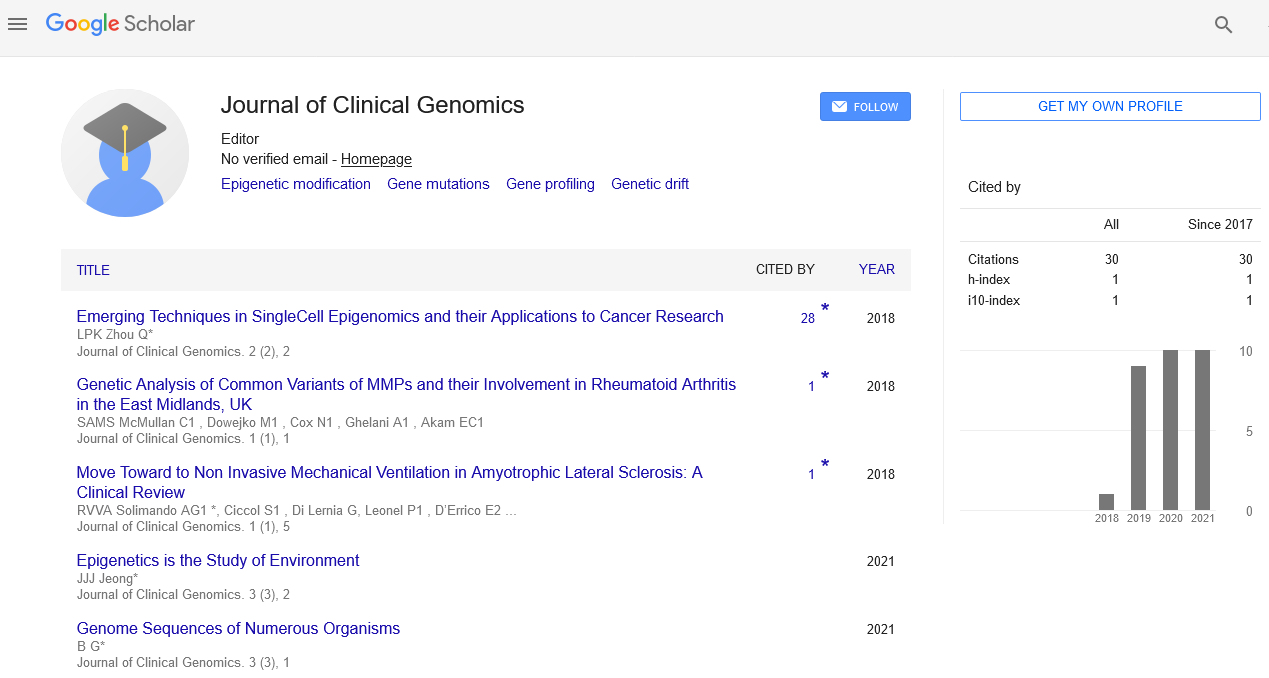Opinion Article, J Clin Genom Vol: 5 Issue: 4
Anlaysing the Techniques, Mechanisms, and Applications of Epigenetic Modifications
Ahmzed Sarenlin*
1Department of Pharmaceutical Biology, Johannes Gutenberg University, Staudinger, Mainz, Germany
*Corresponding Author: Ahmzed Sarenlin,
Department of Pharmaceutical
Biology, Johannes Gutenberg University, Staudinger, Mainz, Germany
E-mail: ahmzed_sarelinjgu11@gmail.com
Received date: 22 November, 2023, Manuscript No. JCG-24-125694;
Editor assigned date: 24 November, 2023, PreQC No. JCG-24-125694 (PQ);
Reviewed date: 11 December, 2023, QC No. JCG-24-125694;
Revised date: 19 December, 2023, Manuscript No. JCG-24-125694 (R);
Published date: 26 December, 2023, DOI: 10.4172/JCG.1000142
Citation: Sarenlin A (2023) Anlaysing the Techniques, Mechanisms, and Applications of Epigenetic Modifications. J Clin Genom 5:4.
Description
Epigenetic modifications, intricate molecular processes that influence gene expression without altering the underlying DNA sequence, have become the focus of extensive studies due to their pivotal role in development, health, and disease. It delves into the various techniques employed in analysing epigenetic modifications, exploring the underlying mechanisms, and examining the diverse applications that arise from this burgeoning field of study. Epigenetic modifications plays a pivotal role in establishing and maintaining cellular identity. During development, cells undergo differentiation into various specialized cell types with distinct functions. DNA methylation and histone modifications contribute to the silencing or activation of specific genes, ensuring that cells adopt and maintain their unique characteristics.
At the core of epigenetic functions is the regulation of gene expression. DNA methylation, particularly at CpG islands, is associated with gene repression, while histone modifications such as acetylation and methylation can either activate or repress transcription. This dynamic regulation allows cells to respond to internal and external signals, adapting their gene expression profiles accordingly. One of the foundational techniques, bisulfite sequencing allows analysts to map DNA methylation patterns. By treating DNA with bisulfite, un-methylated cytosines are converted to uracil while leaving methylated cytosines unchanged. Sequencing the treated DNA provides a comprehensive map of methylated and unmethylated regions.
Chromatin Immunoprecipitation (ChIP) is a powerful technique for studying histone modifications. By using antibodies specific to modified histones, analysts can precipitate chromatin fragments containing these modifications. Subsequent analysis provides insights into the distribution of various histone modifications across the genome. RNA Sequencing (RNA-Seq) is to study the role of noncoding RNAs in epigenetic regulation, RNA-Seq is employed. This technique enables the comprehensive profiling of the transcriptome, allowing experts to identify and quantify various RNA species, including microRNAs and long non-coding RNAs, which play essential roles in modulating gene expression.
Mass spectrometry is instrumental in analyzing proteins, including histones. It allows for the identification and quantification of posttranslational modifications on histones, providing a detailed understanding of the histone code and its role in epigenetic regulation. CRISPR-Cas9 has revolutionized the study of epigenetics by allowing targeted modifications to the genome. Epigenome editing using CRISPR-Cas9 can induce specific changes in DNA methylation or histone modifications at precise genomic loci, enabling experts to investigate the functional consequences of these alterations.
DNA methylation involves the addition of methyl groups to cytosine bases, typically at CpG dinucleotides. This modification often leads to gene silencing by impeding the binding of transcriptional machinery. Histone modifications, such as acetylation, methylation, and phosphorylation, influence chromatin structure and gene expression. Acetylation generally correlates with transcriptional activation, while methylation can either activate or repress gene expression, depending on the specific residues involved.
Non-coding RNAs, including microRNAs and long non-coding RNAs, regulate gene expression at the post-transcriptional level. They can influence mRNA stability and translation, contributing to the finetuning of gene expression patterns. Understanding and targeting aberrant epigenetic modifications in cancer cells provide novel diagnostic and therapeutic avenues. Epigenetic biomarkers can aid in cancer detection, while targeted therapies aim to reverse abnormal epigenetic patterns.
Conclusion
As techniques for analysing epigenetic modifications continue to advance, the understanding of the intricate mechanisms governing gene expression grows deeper. The applications of this knowledge span diverse fields, from diagnosing and treating diseases to advancing personalized medicine. Epigenetic studies is poised to shape the future of healthcare and biology, providing a nuanced perspective on the dynamic interplay between genetics and the environment.
 Spanish
Spanish  Chinese
Chinese  Russian
Russian  German
German  French
French  Japanese
Japanese  Portuguese
Portuguese  Hindi
Hindi 